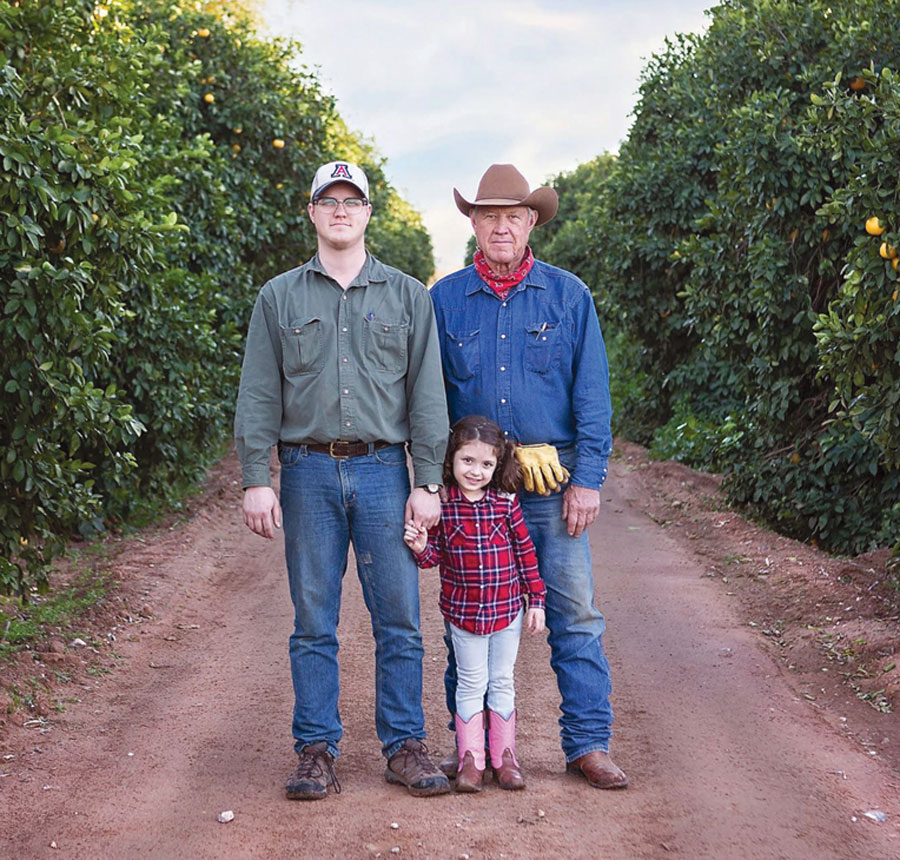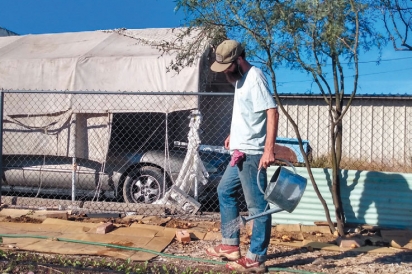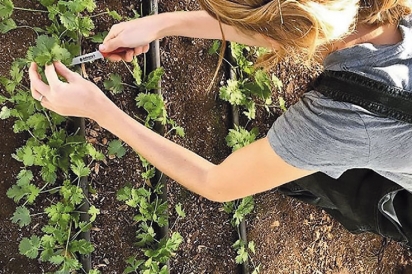Growing New Farmers
GROWING NEW FARMERS IN ARIZONA WITH SB1206
Farming is a robust $23.3 billion industry in our state, encompassing large production agriculture operations as well as small farms. But there is a weak spot: The average age of farmers in Arizona is 61 years, compared to a national average of 55 years.
We need a steady flow of new young farmers to replace those who may soon retire. That is the intent of Senate Bill 1206, the Agricultural Workforce Development Act, advocated by a diverse group of nonprofit organizations, farming groups, Native American farmers, dairymen, nutrition experts and economic development organizations.
The bill offers a new pathway for people who are interested in farming but lack experience, or the time and the means to earn a college agriculture degree. If it passes, SB1206 would add agriculture to the 60 other Workforce Development programs administered by the Arizona Department of Economic Security.
Unlike a century ago, most U.S. citizens today have no connection to farming and no ready access to learn it. As the number of farms dwindles, fewer people grow up in the occupation. Only 1.3% of the 2.6 million people employed in the U.S. work the land to produce food and fiber.
A growing number of young people would like to try to farm in Arizona, but there are obstacles: Land is expensive, water is scarce, capital input is high and so are the risks. Running a farm is a complex undertaking involving not just horticulture and animal husbandry, but marketing, labor and financial management, ecological management, mechanical skills and a web of administrative protocols.
Despite the efforts of the Arizona Farm Bureau, the UA Cooperative Extension and 4-H through programs like Ag in the Classroom and Future Farmers of America, this training is hard to get and the state suffers from a lack of qualified farmers.
Mark Killian, director of the Arizona Department of Agriculture, reports that some dairies in the state are 40% short on labor. Sharla Mortimer, Yavapai County Farm Bureau president and co-owner with her husband of Mortimer Farms in Dewey-Humboldt, has the same problem. They operate a U-pick vegetable and retail farm market, grow some feed crops and raise a few cattle. Mortimer has been advertising for a couple of months for a farm manager, with no luck finding qualified candidates. And that is a key reason for the widespread support of the Agricultural Workforce Development Act.
SB1206 is the fruit of the Arizona Agriculture Workforce Development Coalition led by Nina Sajovic, founder and director of the Center for Sustainable Agriculture in Ajo.
Sajovic convened leaders from the Southern Arizona Young Farmers and Ranchers Coalition, (SAYFRAC), Tohono O’odham Community Action (TOCA), Southern Gila County Development Corporation, Local First Arizona and Iskashitaa Refugee Network to address the needs of young farmers. Vitalyst Health Foundation, a catalyst for community health initiatives and coalitions across the state, provided grant funding for the research and writing of the bill.
Joining forces with entities such as the Arizona Farm Bureau and Pinnacle Prevention, a nonprofit dedicated to family and community health, the coalition drafted a bill with bipartisan support. SB1206 has been approved by the Senate and is currently passing through the halls of the Arizona legislature.
If it becomes law, the bill would be a big step toward filling gaps in Arizona’s agricultural employment needs:
The bill would provide paid internships for young people, immigrants, vets, Native Americans and others who want to learn farming skills but lack the resources and time to go to college.
Another benefit of the program is a rancher-to-rancher grassroots network in support of diversity in Arizona agriculture; Arizona is the only state in the U.S. where more than half of all farmers and ranchers are Native Americans. The network would enable longtime farmers with decades of experience in the local landscape and climate conditions to pass along their knowledge to the next generation.
In addition to providing trained workers for both largeand small-scale farming, dairies and livestock producers, the bill would also benefit gleaners such as the Iskashitaa organization, a refugee network that harvests the leftovers in produce fields. Wild food foragers would benefit too, from training in the best practices of harvesting desert foods such as cholla buds, piñon nuts, cactus fruits and mesquite pods.
Sajovic has seen firsthand the benefits of community support for young farmers. The Ajo Center is a dynamic community resource providing education, internships and economic expansion opportunities for the Native people in the area and other local Ajo residents. It also serves as a support hub, building community for farmers. “Farming is a solitary occupation,” says Sajovic. “Our center is a place where they can find community and support.”
The Center sponsors numerous programs to support and encourage local food production including a USDA grant-funded CSA Internship program that will be the model for SB1206. One cohort of nine people has already completed the program and a second group of 10 interns, mostly in their 20s and 30s but a few as old as 50, is in training.
The program confirms Sajovic’s belief in the possibilities that SB1206 would provide. “The community response has been overwhelming. Many see the market farm model as an economic opportunity which will allow them to stay here in the community.”
Another strong advocate for SB1206 is Cameron Jones, farm manager of Riverview Farms and Five Point Market and Restaurant in Tucson. He became interested in food production while serving in the Peace Corps, where he learned about small-scale farming and experienced the hard work along with the vibrant spirit of community that comes with growing food. Upon his return to the U.S. Jones felt compelled to learn to farm as a way to contribute to community and society. “Farming is a calling, like medicine or teaching,” he says.
Jones feels the workforce development bill would help people like himself more easily find their way into farming: “We need to make it easier for people to become farmers— or someday, if current trends continue, there won’t be many farmers.”
He sees an urgency to transfer the knowledge of long-experienced farmers who understand the growing conditions and challenges. “While there are still folks working the land in our state with skills, experience and resources to share, it is imperative that we connect them with the next generation so they can transfer that knowledge. It would also give them some support as they enter the twilight of their careers and could no doubt benefit from having some extra hands and young backs around.”
2019 was the first year in a decade that SAYFRAC saw an increase of young people entering farming. These entrepreneurs have tapped into the local food movement, CSAs, farm-to-table restaurants, farmers markets and school lunch programs.
“Small market gardens of one to five acres are considered small but are very productive,” says Jones. “There is a need to create the incentives and opportunities for those interested in farming. Farmers are integral to a healthy community, a diverse economy and food security. It will also help fill the gap left by migrant farmers, who now have difficulty coming to work in the United States.”
For more information on the organizations mentioned in this article, see ediblephoenix.com/newfarmers.
Gay Chanler is a professionally trained chef by trade, with an MA in cultural anthropology from Northern Arizona University. A former co-leader of Slow Food Northern Arizona, she currently serves on Slow Food USA’s Southwest/Mountain Ark of Taste Committee.
Impact of COVID-19
The Arizona legislature has halted sessions due to COVID-19, stalling many bills in the pipeline including SB1206. A few weeks ago, the bill’s passage with bipartisan support looked almost certain. But the pandemic may take a toll on the budget and funds that were earmarked for new legislation. Jessie Gruner of Pinnacle Prevention states, “Our state budget will likely look very different when members return to the legislature. We were in a surplus prior to session, so programs like SB1206 had a good chance of getting funded. I don’t believe that will be the case once the dust settles from the pandemic.”
In the current state of economic upheaval with food supply chains threatened or interrupted, there is an urgent need to ensure local food production to feed Arizona. What could be more important than training new farmers to keep the agricultural economy sound and provide food security for all?
It is “not just large scale or small scale, it’s about making sure we have diversified food within our state,” says Patty Emmert, spokesperson for Duncan Family Farms and president of Slow Food Phoenix. “In rural areas, access to food can be limited because there are no stores around, and farms are sometimes the only place nearby producing healthy food.”
For More Information:
Center for Sustainable Agriculture, ajocsa.com
Arizona Food Systems Network, azfsn.org
Pinnacle Prevention, pinnacleprevention.org
Good Food Finder, goodfoodfinderaz.com
National Young Farmers Coalition, youngfarmers.org
Arizona Farm Bureau, azfb.org
Vitalyst Health Foundation, vitalyst.org
Maricopa County Food Coalition, MARCOfoodcoalition.org







